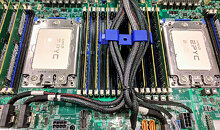Tuesday, December 15th 2020

128-Core 2P AMD EPYC "Milan" System Benchmarked in Cinebench R23, Outputs Insane Numbers
AMD is preparing to launch its next-generation of EPYC processors codenamed Millan. Being based on the company's latest Zen 3 cores, the new EPYC generation is going to deliver a massive IPC boost, spread across many cores. Models are supposed to range anywhere from 16 to 64 cores, to satisfy all of the demanding server workloads. Today, thanks to the leak from ExecutableFix on Twitter, we have the first benchmark of a system containing two of the 64 core, 128 thread Zen 3 based EPYC Milan processors. Running in the 2P configuration the processors achieved a maximum boost clock of 3.7 GHz, which is very high for a server CPU with that many cores.
The system was able to produce a Cinebench R23 score of insane 87878 points. With that many cores, it is no wonder how it is done, however, we need to look at how does it fare against the competition. For comparison, the Intel Xeon Platinum 8280L processor with its 28 cores and 56 threads that boost to 4.0 GHz can score up to 49,876 points. Of course, the scaling to that many cores may not work very well in this example application, so we have to wait and see how it performs in other workloads before jumping to any conclusions. The launch date is unknown for these processors, so we have to wait and report as more information appears.
Sources:
ExecutableFix on Twitter, ServeTheHome (Picture)
The system was able to produce a Cinebench R23 score of insane 87878 points. With that many cores, it is no wonder how it is done, however, we need to look at how does it fare against the competition. For comparison, the Intel Xeon Platinum 8280L processor with its 28 cores and 56 threads that boost to 4.0 GHz can score up to 49,876 points. Of course, the scaling to that many cores may not work very well in this example application, so we have to wait and see how it performs in other workloads before jumping to any conclusions. The launch date is unknown for these processors, so we have to wait and report as more information appears.


25 Comments on 128-Core 2P AMD EPYC "Milan" System Benchmarked in Cinebench R23, Outputs Insane Numbers
Ha. Ha. Ha. "Oh hey Intel, you still dabbling in the sub-100 core counts?" TskI could imagine there's a teenie weenie bit of a RAM bottleneck here. Or maybe Cinebench went crazy and just produced the number 87878.
Why? Because you need each thread to be able to work, or a high number of threads will be idle.
I'm not sure how many tiles are there in R23 render scene but I would imagine the number to be quite low as it is not designed for such monsters.
Lets say the number of tiles is 240, in this case as that system can allocate 256 threads, there will be 16 threads which will not do anything, which results in lower score.
More than this some tiles are more complex than others. You probably noticed that rendering of the tiles in the center take much longer than the tiles on the sides.
This means that all the threads on the sides finish the work and all wait for few threads in the middle, which results again in very low scalability, and very low cpu utilization.
In order to be able to test such system reliably you probably to render the scene in 2500 smaller tiles, and then the scaling will be much better.
7nm cpu and 128- core
let see after year how many core intel make its own 7nm cpu.
amds is so easy to be Elvis with it..erhh. or TSMC's 7nm core...still 14nm rocket lake beat easily all 7nm amd ryzens for gaming.
but....wait.. lets wait 10nm hydrib cpu, adler lake june 2021.
Besides, I bet that score is for 2x28 core Intel.
Should be on the scores list.
EDIT
It's an Epyc rome CPU: www.techpowerup.com/forums/threads/post-your-cinebench-r23-score.213237/page-80#post-4397701
en.wikipedia.org/wiki/Amdahl%27s_law
multi-threading can't scale linear to infinite. at 256 thread, you start to be in the very low gain region.
it did that in some of ltt's epyc/theadripper videos
even the windows version can make a big difference too.
now imagine if you could change to EPYC servers and reduce those 500w to 450w. only 50w per server would mean 5.000 watts less, thats real money in your pocket.